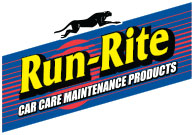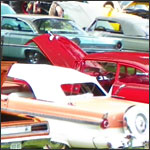|
|
Not only is RockAuto.com EXTREMELY user friendly, it has enough additional info to make intelligent choices as to quality and suitability of a part. Many times, I find very specific details that set my mind at ease, so I order with complete confidence. I recommend RockAuto to everyone, even as a reference source to see what parts SHOULD cost.
John in Arizona
|
Upcoming Events
If you would like your event featured here email with details. |
|
|
Renegade Corvette Club - 10th Annual Open Car & Truck Show
1/10/2016
Sunrise, FL
email
7th Annual Cruizin on the River
1/14/2016
Laughlin, NV
email
2nd Annual Winter Angel Expo Annual Vehicle & Motorcycle Show
1/16/2016
White Pine, TN
email
|
|
Run-Rite SLEDGEHAMMER |

|
Rough idling, reduced gas mileage, misfires, knock and P0420 trouble codes are all signs the fuel system, intake manifold, valves and/or combustion chambers are coated in carbon, soot and varnish deposits. RockAuto now carries SLEDGEHAMMER, a professional strength, detergent based, low VOC compliant product formulated by catalytic converter manufacturer Davico and Run-Rite, maker of specialty cleaners, lubricants and equipment for automotive service centers. SLEDGEHAMMER is designed to safely remove heavy concentrations of carbon, soot and varnish in the engine and fuel system.
After use of SLEDGEHAMMER, you can expect:
- Smoother idle and acceleration.
- Restored fuel economy.
- Longer life from Oxygen Sensors and Catalytic Converters.
- Reduced tailpipe emissions.
- Reduced gasoline octane requirements.
SLEDGEHAMMER removes existing deposits. It is also a preventative maintenance tool that should be used every 50,000 miles. Use it just prior to replacing a Catalytic Converter to protect the new catalyst and thoroughly restore engine performance. You can find SLEDGEHAMMER in the "Tools & Universal Parts" tab under "Fuel/Air" and then "Decarbonizer" in the RockAuto catalog.
|

Happy Holidays |
|
All of us here at RockAuto would like to wish you Happy Holidays and a New Year filled with health and happiness! Thank you for being our customer and letting us serve as your auto parts supplier!
If you are still in need of a gift for the do-it-yourselfer in your life, a RockAuto gift certificate will never go out of style. Everybody needs something for his or her car or truck! They are easy to buy and even easier to use.
Gift Certificate
Purchase gift certificates with a choice of currencies and amounts. Have a paper certificate shipped to you or directly to the recipient, or choose E-Gift.
E-Gift
Need a Christmas gift in a hurry? E-Gift delivery is immediate and free. Simply select Email as the shipping option and your friends and family will conveniently receive the gift in their inbox.
Purchase a Gift Certificate today! |

Forum of the Month |
|
The Chrysler Minivan Fan Club Forums site has active topics pertaining to all generations of the Chrysler family of minivans. Thousands of discussion topics range from the first generation (1984-1990), up to the sixth generation (2017) models. There are also active topics on Chrysler SUV and crossover vehicles!
If you are the
administrator or member of a forum
and you would like to see your website
featured in an upcoming newsletter
and receive a discount code to share
with your members, contact marketing@rockauto.com. |

Repair
Mistakes & Blunders |
|
I've always maintained my own vehicles, from motorcycles to cars and trucks. I even spent a year working in an automotive repair shop.
My sister-in-law drives a 2005 Nissan Murano and complained of a horrible groaning sound, so I asked her to bring her car by. The power steering fluid was low. I filled it up and the noise went away. I informed her there was a leak and to keep the power steering fluid topped off.
It got to the point that she was filling it every other day. I looked at it and could easily tell the fluid was leaking from the high pressure line between the power steering pump and the steering rack. We got the part, and I got busy on the repair the next day. I removed the old line and installed the new one, taking my time so I didn't break anything. The new line went in easily enough. I got the fitting on the pump finger tight, then proceeded to tighten all the fittings on the steering rack. I was almost done. I filled the reservoir and started the engine. The pump was making some noise, but I knew I had to bleed the system. I turned the wheels back and forth, filled the reservoir, turned the wheels again and repeated this a few more times. I went through two quarts of fluid, and it was still making a bit of noise. Then, it dawned on me...I never went back and tightened the fitting on the pump. Oh MAN! I had power steering fluid all over the floor!
I tightened the fitting, topped off the reservoir and life was good...except for the mess on my floor.
Craig in Virginia
Tell us about
your most infamous auto repair blunder
or unconventional fix. Use your woe
to help others avoid similar mistakes
or share off-the-wall solutions that
worked (at least for a while!). Please
email your story to flamur@rockauto.com.
Include your mailing address and if
you would like a RockAuto T-Shirt
(please let us know your shirt size)
or Hat if we publish your story. See
the T-Shirts and Hats under Tools
& Universal Parts in the catalog.
The story will be credited using only
your first name and your vague geographic
location (state, province, country,
continent, etc.) so you can remain
semi-anonymous! |

Automotive Trivia |

|
What is the ideal gasoline air-fuel ratio:
A. 26.3 parts air to 1 part fuel
B. 7 parts air to 2 parts fuel
C. 14.7 parts air to 1 part fuel
Answer below |

Winter Fuel Economy |

|
A reader from Ontario recently reported his truck uses significantly more gasoline in cold weather. He asked if winter fuel economy suffers because fuel injected engines do not have heat risers like old carbureted engines do. Great question!
A heat riser uses the hot exhaust manifold to preheat air entering the carburetor. Typically there is a steel box attached to the exhaust manifold and a pipe ("pre-heater hose" under "Fuel/Air" in the RockAuto catalog) running from the box to the air cleaner inlet.

pre-heater hose between exhaust manifold and air cleaner inlet A carburetor delivers the same amount of gasoline whether the incoming air is hot and thin or cold and dense. Heat risers help maintain the correct fuel/air ratio by ensuring the incoming air is within a set temperature range.
Most fuel injection systems do not need pre-warmed incoming air. Air charge temperature, manifold pressure (MAP), mass air flow and other sensors (found under "Fuel/Air" and "Emission") tell the engine computer how dense the incoming air is. The flow of air and fuel injector on/off cycles (pulse width) are adjusted continuously to maintain the optimum fuel/air mixture. Fuel injectors operate at high pressure so the gasoline can be properly vaporized even at colder temperatures.
What has a big impact on a fuel injected engine's winter fuel economy is how quickly it warms up to operating temperature and moves from "open loop" to "closed loop" operation. Engines are usually in open loop mode when they are started cold or during unique events such as wide open throttle. Open loop means the fuel/air system runs using parameters already stored in the computer.
Closed loop mode means the computer (found under "Electrical") is now getting feedback from the oxygen sensor(s). If an O2 sensor indicates the fuel/air mixture is too rich or too lean then the computer immediately adjusts the fuel injector pulse width. The fuel injector pulse width might be twice as long in open loop mode compared to the average pulse width in closed loop mode. Open loop mode often uses more gasoline than is necessary and fuel economy suffers.
A heat riser would help an engine warm up a little faster, but the benefit would probably not be worth the trouble of fabricating a do-it-yourself heat riser system. Here are a few of the parts already on modern engines that should be questioned if an engine is slow to warm up and enter fuel efficient closed loop mode: Is an old thermostat (found under "Cooling System") allowing cold engine coolant to circulate through the radiator? Is a failing coolant temperature sensor slow to tell the computer the engine is warm? Has an oxygen sensor become sluggish or is its internal heater broken?
On super cold days in my wife's hometown in northern Minnesota, some drivers block off their grilles with cardboard (found enclosing most RockAuto parts orders!) in an attempt to create a "heat riser" effect using the entire engine compartment.
Tom Taylor,
RockAuto.com
Tom's Follow-Up Note: Several readers pointed out that "heat riser" is not
the correct name for the intake air pre-heat system the Ontario reader
asked about and which is described above. A "heat riser" is the plumbing
that routes engine exhaust from an exhaust manifold to the intake manifold
when the engine is cold. Warm exhaust gas heats up the base of the
carburetor which helps the gasoline vaporize. A temperature controlled
heat riser valve in the exhaust manifold typically stops the flow of
exhaust once the exhaust/engine are sufficiently hot.
Exhaust gas heat risers were common on carbureted and early throttle body
fuel injected engines. Modern high pressure fuel injectors do not need
heat risers to vaporize the gasoline. Like pre-heating the intake air, an
exhaust gas heat riser system would help warm up an engine a little
faster, but that probably would not be worth the costs. The valve in the
exhaust manifold is often prone to rattling. I remember being surprised
decades ago when exhaust gas started shooting out of a rust hole in my
Chrysler V8's intake manifold.
To read more of Tom's articles, click this link and choose from story titles on the Newsletter Archives page. |

| Anthony's 1966 Buick Sportwagon |
|
This is my family's 1966 Buick Sportwagon. My father purchased this car in 1976 from my aunt who had purchased it new in 1966. I am the oldest of seven, and this was the family wagon from 1976 until 1986, when I turned 16 and began driving it to high school. Although ownership always remained with my father, this was my primary transportation throughout high school (I delivered pizza in it most nights those four years) and into college. After my first two years of college I replaced it with a daily driver of my own in 1990, and my dad retired it out back of the family home under a large cherry tree where it sat until 2011. My father had wanted to restore it himself, but the size of this project was apparently too daunting for him. So he delivered it to my home and told me to do what I wanted with it. Scrap it, restore it, whatever.
My wife, kids, and I restored the car in 2015 in anticipation of the 2015 annual Peach Days Car Show in Brigham City, Utah. It was our goal to have it completed by then, and we met that goal. We completed the entire project ourselves! It is painted Tangerine Twist Orange. My wife custom tailored the entire interior, from the black tuck and roll alligator skin leather and vinyl seats, to the light gray headliner. All interior and engine colors are original, only the exterior color was changed. This car was optioned with custom chrome trim (Sport Wagon Custom). It has the original Super Turbine 300 transmission, ice cold R-12 AC that didn’t even need re-charging after decades of sitting, and 340 cubic inch Wildcat 375 engine. (Editor note: Buick's "Wildcat 375" decal on the air cleaner indicates the engine has a 375 ft. lb. torque rating.)
RockAuto provided many of the parts for the restoration including ignition, belts, hoses, filters, brakes and much more!
Anthony in Utah
|
Share Your
Hard Work |
Do you purchase parts from RockAuto? If so, RockAuto would like to give you the opportunity to have your car or truck possibly featured in one (or occasionally more) of our publications such as the monthly newsletter, collector magnets or RockAuto social media.
New, old, import, domestic,
daily driver, trailer queen,
classic, antique, we want to
see them all! Please email flamur@rockauto.com with your vehicle's history,
interesting details, your favorite
images and what parts from
RockAuto you have used.
|
Let
RockAuto Help |

|
Are
you organizing a car show or
other auto related event? From
goody bag stuffers to gift certificates...RockAuto
can help. We can even publicize
your event in our newsletter.
Just
send an email to marketing@rockauto.com with information about your
show.
|
Automotive
Trivia Answer |

|
What is the ideal gasoline air-fuel ratio:
A. 26.3 parts air to 1 part fuel
B. 7 parts air to 2 parts fuel
Answer C. 14.7 parts air to 1 part fuel
Back up to trivia question |
© 1999-2015 RockAuto, LLC - Madison, Wisconsin USA. RockAuto name, logo and ALL THE PARTS YOUR CAR WILL EVER NEED are registered trademarks of RockAuto, LLC. Manufacturer names and logos in the RockAuto catalog are trademarks of their respective companies and are used only to identify their products. All rights reserved. |
|
|
|
|